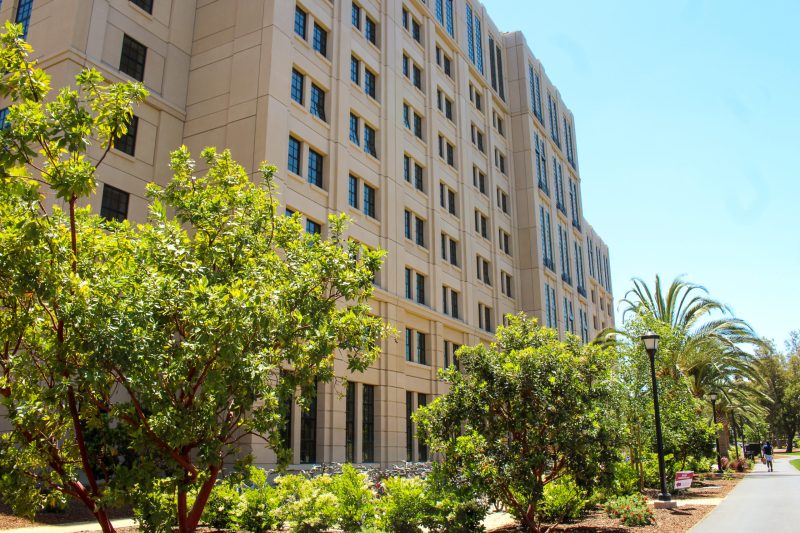When sixth-year sociology Ph.D. student Lisa Hummel moved into Escondido South graduate residence (EV South) with her pregnant wife, she did not expect to have COVID-19-positive students flocking to her courtyard. But after her neighbor received a surprise visit at her door from two students looking for the COVID-19 isolation check-in point, Hummel and other EV South residents began to worry.
Now, EV South residents are asking the University to move the COVID-19 isolation check-in office away from their building. More than 90 Stanford affiliates — residents, students, staff and faculty, among others — signed a petition that was sent to Residential and Dining Enterprises (R&DE) and Stanford administrators on Jan. 14.
“We are writing to you as concerned students and parents,” began the petition, written by Hummel. “EV South is a community that contains some of Stanford’s most vulnerable members including pregnant people, newborn babies, children too young to get vaccinated and children not yet eligible for a booster.”
But while Hummel and many of her neighbors just recently learned of the check-in office, it has been located at EV South since October 2021, according to an email sent to petitioners by R&DE Executive Director Imogen Hinds.
According to Hinds, the University selected EV South for isolation check-in because it is near the on-campus isolation facilities at Studio 2 and Escondido Village Graduate Residences Building B, is near street parking and is “more accessible and safe to students who need to visit the office without entering a campus building.”
Hinds also wrote that EV South is a “location that supports simple directions,” yet some students have reported difficulties finding it.
Still, the news comes as a surprise to residents — Hummel and her neighbors said they received no communication from Stanford that there would be an isolation check-in stationed in their housing complex. And amid record-high COVID-19 case counts on campus, the flow of potentially-contagious students walking through their building has only grown.
When Hummel’s wife found out about the check-in, she questioned why she, “as a pregnant person who’s about to give birth […] has to worry about stepping outside and potentially running into unmasked, COVID-positive students,” Hummel said.
While many residents of EV South take issue with the placement of the check-in office, others note that the University has “to have this check-in unit somewhere. If it’s not in my backyard, it will be in your backyard,” said Suchit Rout M.S.x ’22.
A primary concern of the petitioners was also a lack of signage that there were COVID-19-positive individuals in the area. So many people, including delivery drivers, walk right through the group of students checking in to isolation, according to Rout.
“There is no signage there that these people are COVID-positive,” Rout said. “So I pulled up to the UPS person, and I actually told her to park somewhere else.”
In response to the petitioners’ concerns about signage, the University “will be installing additional signs, to make clear where students should and should not go,” Hinds wrote. Rout has since said that new signage has been posted. But there is still no mention of signage for others passing through the area.
The reported lack of initial signage is what led the COVID-19-positive students to the door of Hummel’s neighbor, who asked to remain anonymous for personal safety concerns.
“It freaked me out that had they had 15 more seconds they would’ve entered my house unmasked and COVID-positive,” said the student. “So I sent our neighborhood group chat a warning to lock their doors while they’re home in the off-chance this happened again.”
To help prevent further situations like this, Hinds said staff will remind students to stay away from other residences and wear masks while in line or leaving the office.
“We have also taken steps to better manage surges in check-in traffic that may have resulted in students waiting outside the office,” Hinds wrote.
Hinds offered no indication that the isolation check-in area will be moved and instead wrote that R&DE has not “been able to identify another location with the same essential characteristics” as EV South.
While Hummel and her fellow signatories still hope for the isolation check-in office to be moved, Hinds wrote, “Our hope is that, after most students are on campus by the end of this week, we will see a dramatic decrease in the number of students needing isolation and a commensurate reduction in foot traffic in the area.”
“I am unclear why residents of EV South were neither consulted with nor notified of this plan at any point,” Hummel wrote to The Daily in response to Hinds’ email. “We need specific policies and structural support in place, which it sounds like in the case of EV South, the University is unwilling to provide.”
